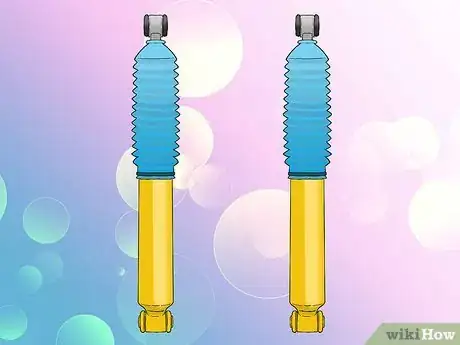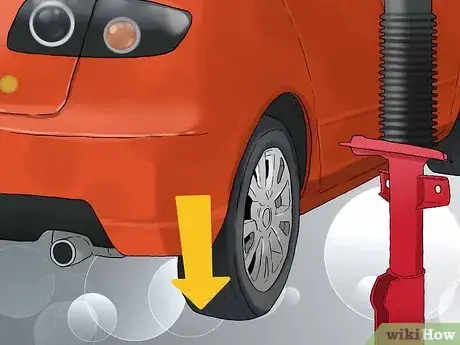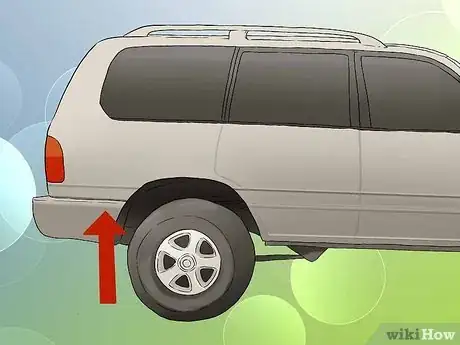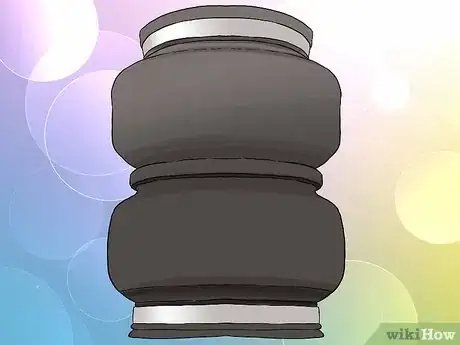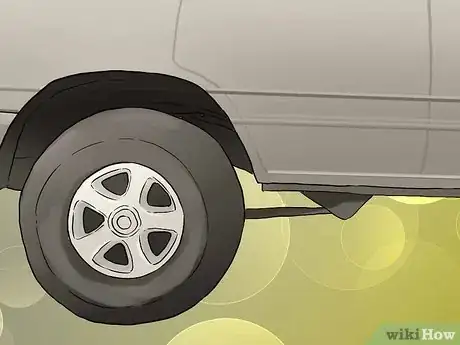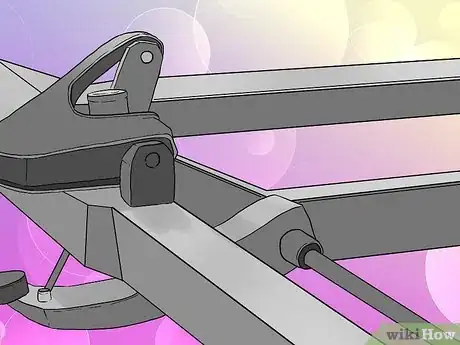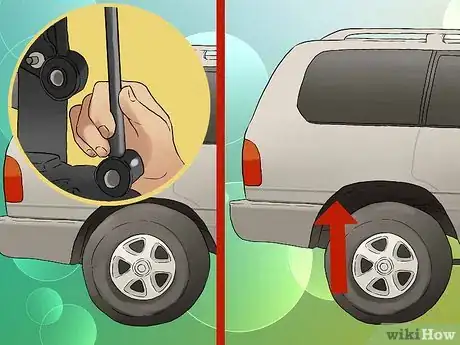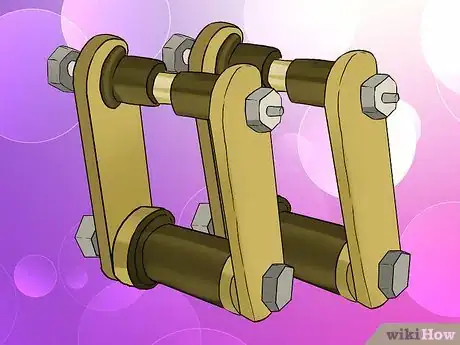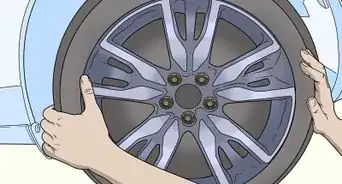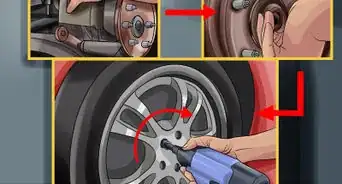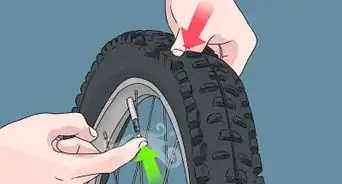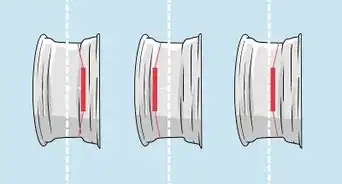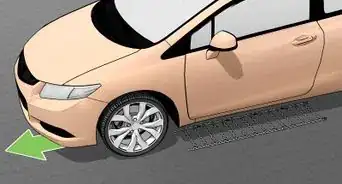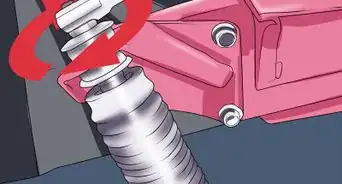wikiHow is a “wiki,” similar to Wikipedia, which means that many of our articles are co-written by multiple authors. To create this article, volunteer authors worked to edit and improve it over time.
There are 8 references cited in this article, which can be found at the bottom of the page.
This article has been viewed 77,028 times.
Learn more...
So it's time to get new shocks, and you've decided to try to make some improvements while you are at it; or perhaps you have a car or truck which is being put to work, carrying heavier loads or doing some towing. In this case, an upgrade to your suspension is in order.
Steps
Upgrading Only Your Shocks
-
1Get some new shocks. The first and fastest way to beef up your suspension is just to upgrade your shocks. This might be something as simple as buying the next-more-expensive OEM replacement, or by going so far as to add fancy high dollar upgrades that might well have the side effect of wrecking your driving experience, even as they add a little more of the desired stability and reliability.[1]
-
2Be wary of getting too wild. Consulting with your local counterman is a good idea, but keep in mind that he is out to sell you product, and might not be as much of an expert as he thinks he is.
- Any time you veer away from OEM equipment you are taking a gamble, and as a general rule, the industry translates 'improvement' and 'upgrade' as stiffer, less pliable shocks.
- This can help you control a saggy rear end and might do a better job of keeping your tires on the ground where you need them, but doesn't translate to a smooth or comfortable ride.
Advertisement -
3Look for heavy duty shocks if necessary. It is very difficult to predict how after-market shocks will affect your overall driving experience, despite the many claims made by marketing experts and salesmen.
- That said, if you mean to be carrying heavy loads up to and including towing, it is probably a good idea to go for heavy duty shocks, even coil-over or air shocks, to keep your rear end from bottoming out.
Upgrading for Heavier Loads
-
1Consider getting heavy duty shocks or struts. Putting a big steel brush guard on your Jeep? Rigging up your truck to pull a trailer? Go for heavy duty shocks. No reason to get crazy just yet, but if you habitually haul a trunk of luggage or a bed full of boulders, or if you intend to haul a camper or boat or something, beefier shocks are your best first step.
- When buying your upgrades be careful to check for compatibility, and unless you are also doing a lift job, steer clear of those models which call for a 2" (or more) lift.
- These might add to your clearance a little by themselves, but are actually intended to compensate for a lift job, not to provide one. You'll end up with less travel on your shocks, and likely ruin them pretty quickly.
-
2Think about getting "ride adjusting" shocks. These shocks can go a long way towards keeping you from sagging and bottoming out while hauling things.
- When doing such an upgrade, it's best to replace shocks at all four wheels with a more or less equivalent quality, though the 'ride adjusting' and air shocks are generally only for your rear wheels.
- Air shocks are particularly interesting, as they can be stiffened up for heavier loads, or softened for smooth but stable ride.
-
3Reinforce your springs. You might also consider reinforcing your springs when getting ready for heavy hauling. If your machine has leaf springs (common on trucks and many cars for rear suspension) you can simply have a leaf added, or 'spring helpers' that bolt on to your existing springs to add tension and strength, giving you as much as a ton (or more) of extra load-bearing capability.[2]
- Coil springs are more common on the front wheels, and can likewise be reinforced by fairly cheap, easily applied supports - generally a polyurethane brace that can be slipped into the spring coil, reducing the amount of play in the spring without adding any additional ride height.
- Both of these spring helpers can actually increase your ride height by a small amount, though this does not count as a lift. Leaf spring and coil spring reinforcement simply reduces the amount your vehicle chassis weight compresses the springs, which may render a slightly lifted appearance.
- Wheel travel is not generally affected, and if you did it just right, your additional weight will bring things back to about normal. By all means put in heavy duty shocks, but stick to the OEM fit.
-
4Insert air springs. To really solidify your ride, airbag or air spring inserts can be added to coil spring suspensions, which are reputed to significantly reduce sag and bounce.
- Some kits can be self-installed with basic tools, but they are generally not an inexpensive option anyway, and might be best left for professionals to install for you, as they generally require dropping axles and removing the springs.
- While this is not the end of the world, it is potentially problematic and dangerous if you don't know what you are doing.
-
5Think about getting bigger wheels. The above improvements might be plenty if you need a little extra clearance for your oversized tires or larger diameter wheels with the low profile tires that have become fashionable.[3]
- If going for these options, keep in mind that low profile tires, while reputed to provide better handling in adverse road conditions, can really make for a much less comfortable ride.
- Conversely, oversized tires can add a little extra cushion and even improve mileage somewhat, but require more torque to move, and can affect performance as a result.
- Usually there is a little slack as far as tire/wheel sizes, especially on trucks, but if you intend to make that change for whatever reason, try them on first and make sure they clear your front wheel wells and cowling when turning, and don't scrape when you hit bumps. If you have these problems, but insist on the wheel/tire change, you're going to need a minor lift.
Lifting Your Car
-
1Consider adding torsion bars. Many trucks have adjustable torsion bars, which will allow you to make adjustments to the ride height in the front of the vehicle, raising it to match a lift in the rear, or lowering it to keep it level if the rear springs are being taxed, rendering that 'saggy bottom' look.[4]
- Check your owners manual for adjustment procedures or better yet, since you will need a re-alignment after adjusting your ride height, just take it in and let your alignment specialist do it for you.
- Torsion bar adjustment in the front along with leaf spring helpers in the back, and heavy duty shocks all the way around, and you can keep your truck level, or hike it up, or even give it a fancy aggressive 'rake'.
- Keep in mind that torsion bar adjustments do not increase your travel range; only the clearance of your wheel well over your tire, which for our purposes should be plenty.
-
2Try out a lift kit. Use your best judgment when it comes to using a lift kit. Lift kits can be found that provide an inch, two inches, three inches and so on, until you are replacing every single component of your suspension from sway bars to tie rods just to keep up with your hunger for more clearance and ride height.
- Don't get carried away. Just a couple of inches can make a dramatic difference, and every time you add to your clearance height, you have to get new shocks to match, and at some point you're just sacrificing stability and reliability, as well as making it harder to get into your trunk or truck bed.
- If you want to go full mud-bogger monster truck, you'll find instructions for that elsewhere. For now, consider this to be the last resort for keeping your cushy old Chevy from scraping wheels and dragging your trailer tongue every time the road gets a little bumpy.
-
3Pick out the right size of lift kit. You've already got spring helpers and better shocks in place, and you are still riding low in the back. Go for a 2" (or even a 1.5") lift kit.
- For coil springs this is usually another polyurethane insert, that just lowers the point where your spring connects to the chassis. For leaf springs this is just a shim that goes where your springs come into contact with your axle, and sometimes with shackles to adjust where they connect on the chassis side.
- If you are very lucky, you can boost up the rear end (again, matching heavy duty shocks, of a length that reflects your lift) and just use torsion bars to compensate and level your front ride height.
- In some cases (where there are no adjustable torsion bars) you'll need a lift kit that covers all four wheels, unless you are okay with having your rear end sitting higher than your front when your vehicle is unloaded.
-
4Look at the contents of your lift kit. More complete, well rounded lift kits can be found which actually include longer springs and shocks and peripheral hardware.
- If you really want or need a couple of extra inches, these present a trade off, removing some doubts and calculations for getting everything to match up, but require some serious work to install. If you have the resources, consider a professional installation.
- In any case, once you are lifted, be mindful of your alignment, and make adjustments, or better yet, take it in and have your alignment professionally dialed in.
Community Q&A
-
QuestionHow can I prevent it from hitting the bottom?
 Uglymug18Community AnswerIf a shock is bottoming out it is too tall and must be changed out. It is too long for the travel of the vehicle or there is a suspension issue allowing the wheel to travel too far.
Uglymug18Community AnswerIf a shock is bottoming out it is too tall and must be changed out. It is too long for the travel of the vehicle or there is a suspension issue allowing the wheel to travel too far. -
QuestionHow do I adjust shocks on a go-cart?
 Uglymug18Community AnswerMost go-cart and four wheeler shocks use a spanner wrench at the top of the shock to adjust. It will be a flat piece of metal just above the spring with notches in it. If you turn it to the right it tightens the suspension and the left makes it softer.
Uglymug18Community AnswerMost go-cart and four wheeler shocks use a spanner wrench at the top of the shock to adjust. It will be a flat piece of metal just above the spring with notches in it. If you turn it to the right it tightens the suspension and the left makes it softer. -
QuestionIf I put on heavy duty shocks that are 2 1/2 inches taller, will i have to do anything to the leaf springs to have a more comfortable ride?
 Uglymug18Community AnswerA longer shock will not give a better ride. 2.5" longer will be way too long for stock suspension unless you plan on putting a lift kit in also.
Uglymug18Community AnswerA longer shock will not give a better ride. 2.5" longer will be way too long for stock suspension unless you plan on putting a lift kit in also.
References
- ↑ https://shop.advanceautoparts.com/r/advice/car-maintenance/what-to-know-before-replacing-your-own-shocks-or-struts
- ↑ https://www.youtube.com/watch?v=DnD87aRsEmY
- ↑ https://www.popularmechanics.com/cars/how-to/a3682/4281033/
- ↑ https://images.oreillyauto.com/parts/img/documents/ran/rancho_installation_instructions_for_rs66300r5_revision_a.pdf
- http://mechanics.stackexchange.com/questions/3363/in-what-order-does-it-make-sense-to-upgrade-suspension-components
- http://www.streetdirectory.com/travel_guide/50768/car_parts/upgrade_your_vehicles_suspension_system_for_shocking_results.html
- http://upgrademotoring.com/suspension/index.htm
- https://www.knowyourparts.com/technical-resources/suspension/complete-suspension-components-upgrade/
About This Article
Upgrading your car's suspension is a great way to improve its handling and stability, and you have a few different options to choose from. The easiest way to improve your suspension is to buy aftermarket shocks. These can improve the stability of your ride and make the suspension a little stiffer. If you need to carry heavy loads, you can protect your car by installing heavy duty shocks on it. You can also get “ride adjusting” shocks or air shocks to keep your back end from sagging under the extra weight. If you want to raise your vehicle higher off the ground, install a lift kit or take it to a garage to get a professional to do it for you. For more tips, including how to reinforce your springs, read on!


